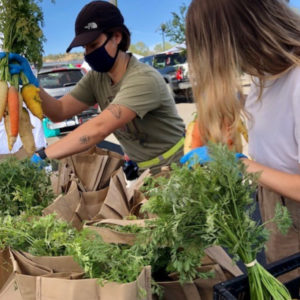By: Abigail Martone-Richards, ASU Food Systems graduate student.
The Prescott Farmers Market in Prescott, Arizona was founded in 1997 as a seasonal market, expanding to year-round in 2014. Heading up the market is Executive Director Kathleen Yetman who, in addition to running the market, is pursuing a master’s degree in Sustainable Foods Systems through Arizona State University. Currently, Kathleen oversees a staff of 9 people who run all operational aspects of the market and has plans to double her staff as the market continues to grow. Each week the market is made up of 50-60 vendors and averages 4,000 visitors from Prescott and the surrounding area, resulting in approximately $30,000 in weekly sales. The market’s mission, “to support and expand local agriculture, cultivate a healthy community and increase access to affordable local food,” is the guiding force as it looks to expand its current programming and meet ambitious future goals.
Current operations and programming:
Because the market has a significant economic impact, Kathleen and her staff are always looking for ways to innovate and expand to better serve the community in Yavapai County. As a 501(c)3 organization, the market is funded through grants and donations which allows the market to meet its operational needs each week and continue growing. Current programs include Carrots for Kids, which provides healthy snacks to kids during the market and Chefs in Action, which gives local chefs the opportunity to showcase their creations to market visitors. There’s also a Seed Library initiative in partnership with the Prescott Public Library which allows residents to obtain seeds using their library cards and a Zero Waste campaign to ensure all waste from the market ends up in the appropriate place via composting, recycling, and landfill sorting.
Larger programs that have been launched at the start of the Covid-19 pandemic include Community Composting and Feed Your Neighbors. The former is a USDA-funded program that provides market customers an outlet to compost their food scraps. Food waste from the market, the local food bank, and a handful of local restaurants is collected weekly and then transported to a composting site nearby, where volunteers mix it in with additional green and brown matter. After curing for several months, the compost is transported back to the market for distribution. The composting operation is overseen by a Compost Manager employed by the market.
The Feed Your Neighbors program was established in March of 2020 to address food access issues during the pandemic. This program, which is 100% donor supported, has been able to provide local food to over 500 needy families and supported local farmers who otherwise were not able to easily distribute their products. Each week, market staff arranged to pick up food from local farms and ranches and assembled items into boxes, each of which could feed a family of 4 for a week. For the next year and a half, the market would distribute over $40,000 worth of food, ensuring food security for residents in need. Programs like this, as well as the market’s long-term acceptance of national food assistance through SNAP, EBT, and WIC, has ensured access to fresh, local food to those who can’t easily afford it.
Future plans:
Under Kathleen’s leadership, the market has big plans to continue growing and expanding its programming in the years to come. One of the main goals is to launch a Food Hub thanks to a grant from the USDA. The Food Hub has three important goals. The first is to provide a central place to collect food from producers and distribute it to local restaurants, the second is to provide a commissary kitchen to food entrepreneurs, and the third is to serve as an incubator for food-related businesses. Currently, the Food Hub plans are in development and the market is looking to hire a full-time Food Hub Manager to oversee it.
In addition to the ambitious Food Hub project, the market is looking to continue supporting farmers by finding ways to distribute their products wholesale to restaurants and school systems. This would provide greater stability to local food producers as well as benefiting the market as it continues to grow. The market consistently welcomes more and more visitors, especially as the food assistance programs are better utilized. Although the market does conduct marketing through canvassing and digital means, the biggest driver of new customers is word-of-mouth. As the population of Prescott and Yavapai County are projected to grow in coming years, it’s exciting to see that the market is thoughtfully preparing to meet that growth and provide important resources to the local community.
This blog is part of a series from the December 2021 Arizona immersive component of the MS in Sustainable Food Systems Program. Students toured the state, meeting with farmers, ranchers, entrepreneurs, government staff, and non-profit leaders.
